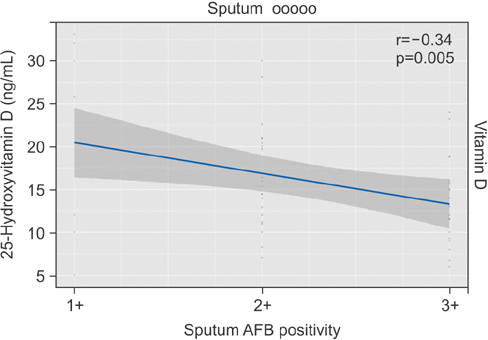Tuberc Respir Dis.
2016 Jul;79(3):153-157. 10.4046/trd.2016.79.3.153.
Association of Serum Vitamin D Levels with Bacterial Load in Pulmonary Tuberculosis Patients
- Affiliations
-
- 1Department of Biochemistry, Jawaharlal Institute of Postgraduate Medical Education & Research (JIPMER), Pondicherry, India. sridhar_biochem@yahoo.co.in
- 2Department of Pulmonary Medicine, Jawaharlal Institute of Postgraduate Medical Education & Research (JIPMER), Pondicherry, India.
- 3Department of Medicine, Jawaharlal Institute of Postgraduate Medical Education & Research (JIPMER), Pondicherry, India.
- KMID: 2326683
- DOI: http://doi.org/10.4046/trd.2016.79.3.153
Abstract
- BACKGROUND
Vitamin D is known to have diverse effects on various systems in the body. There is evidence to suggest that a link exists between the serum vitamin D status and tuberculosis. The present study was designed to assess the alterations in serum 25-hydroxyvitamin D levels in newly diagnosed sputum acid fast bacilli (AFB) positive pulmonary tuberculosis patients and to study the association, if any, between serum vitamin D levels and different levels of sputum smear positivity.
METHODS
Serum 25-hydroxyvitamin D levels were estimated in 65 sputum AFB positive pulmonary tuberculosis patients and 65 age and gender-matched healthy controls.
RESULTS
The levels of serum 25 hydroxy-vitamin D in tuberculosis patients were not statistically different from the levels of serum 25 hydroxy-vitamin D in healthy controls. However, among patients with pulmonary tuberculosis, there was a significant negative correlation between the levels of serum 25 hydroxy-vitamin D and levels of sputum positivity.
CONCLUSION
Serum vitamin D levels negatively correlates with bacterial load in patients with active pulmonary tuberculosis.
Keyword
MeSH Terms
Figure
Reference
-
1. World Health Organization. Global tuberculosis control: WHO report 2011 [Internet]. Geneva: World Health Organization;2014. cited 2014 Jul 16. Available from: http://www.who.int/tb/publications/global_report/2011/en/.2. Thacher TD, Clarke BL. Vitamin D insufficiency. Mayo Clin Proc. 2011; 86:50–60.3. Londhey V. Vitamin D deficiency: Indian scenario. J Assoc Physicians India. 2011; 59:695–696.4. Harinarayan CV, Joshi SR. Vitamin D status in India: its implications and remedial measures. J Assoc Physicians India. 2009; 57:40–48.5. Zasloff M. Fighting infections with vitamin D. Nat Med. 2006; 12:388–390.6. Jhun BW, Kim SJ, Kim K, Lee JE, Hong DJ. Vitamin D status in South Korean military personnel with acute eosinophilic pneumonia: a pilot study. Tuberc Respir Dis. 2015; 78:232–238.7. Hansdottir S, Monick MM, Hinde SL, Lovan N, Look DC, Hunninghake GW. Respiratory epithelial cells convert inactive vitamin D to its active form: potential effects on host defense. J Immunol. 2008; 181:7090–7099.8. Davies PD, Church HA, Brown RC, Woodhead JS. Raised serum calcium in tuberculosis patients in Africa. Eur J Respir Dis. 1987; 71:341–344.9. Sasidharan PK, Rajeev E, Vijayakumari V. Tuberculosis and vitamin D deficiency. J Assoc Physicians India. 2002; 50:554–558.10. RNTCP. Tuberculosis manual [Internet]. New Delhi: Government of India, Central Tuberculosis;2005. cited 2016 Mar 1. Available from: http://www.tbcindia.nic.in/pdfs/RNTCP%20Lab%20Network%20Guidelines.pdf.11. G R, Gupta A. Vitamin D deficiency in India: prevalence, causalities and interventions. Nutrients. 2014; 6:729–775.12. Nnoaham KE, Clarke A. Low serum vitamin D levels and tuberculosis: a systematic review and meta-analysis. Int J Epidemiol. 2008; 37:113–119.13. Wejse C, Olesen R, Rabna P, Kaestel P, Gustafson P, Aaby P, et al. Serum 25-hydroxyvitamin D in a West African population of tuberculosis patients and unmatched healthy controls. Am J Clin Nutr. 2007; 86:1376–1383.14. Tostmann A, Wielders JP, Kibiki GS, Verhoef H, Boeree MJ, van der Ven AJ. Serum 25-hydroxy-vitamin D3 concentrations increase during tuberculosis treatment in Tanzania. Int J Tuberc Lung Dis. 2010; 14:1147–1152.15. Liu PT, Stenger S, Tang DH, Modlin RL. Cutting edge: vitamin D-mediated human antimicrobial activity against Mycobacterium tuberculosis is dependent on the induction of cathelicidin. J Immunol. 2007; 179:2060–2063.16. Kim SH, Baek MS, Yoon DS, Park JS, Yoon BW, Oh BS, et al. Vitamin D inhibits expression and activity of matrix metalloproteinase in human lung fibroblasts (HFL-1) cells. Tuberc Respir Dis. 2014; 77:73–80.
- Full Text Links
- Actions
-
Cited
- CITED
-
- Close
- Share
- Similar articles
-
- Serum Concentrations of Vitamine D Metabolites in Patients with Untreated Tuberculosis
- Vitamin D Status in South Korean Military Personnel with Acute Eosinophilic Pneumonia: A Pilot Study
- Are children with asthma in South Korea also associated with vitamin D deficiency?
- Serum levels of folic acid and vitamin B12 in Korean patients with vitiligo
- The Relationship Between Serum 25 Hydroxy Vitamin D Levels and Asthma in Children


